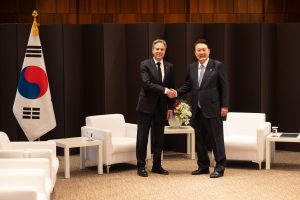On March 18, U.S. Secretary of State Anthony Blinken and his South Korean counterpart met for the second time in under a month. This time, Blinken is on a three-stop trip to Vienna, Seoul, and Manila from March 14 to 20.
In Seoul, he led the U.S. delegation to attend the ministerial segment of the third Summit for Democracy (S4D) hosted by the Yoon Suk-yeol administration. Under the theme of “Democracy for Future Generations,” the summit focused on strengthening democratic governance, protecting human rights, and advancing the fight against corruption. Blinken also held bilateral talks with South Korean Foreign Minister Cho Tae-yul and other officials to discuss the South Korea-U.S. alliance, democracy, and the Korean Peninsula.
The fact that South Korea hosted the third S4D this year is noteworthy. The S4D is a U.S.-led multilateral gathering meant to promote solidarity and shared values among democratic countries – and, more broadly, to consolidate the U.S. alignment with its like-minded partners all over the world. The mechanism, initiated by the Biden administration, was first held in 2021 as a U.S.-hosted online platform. Two years later, the second S4D was held virtually, co-hosted by Costa Rica, the Netherlands, South Korea, and Zambia. Nearly one year later, South Korea is the very first country to host in-person meetings for the S4D, a platform closely embraced by U.S. President Joe Biden.
The third S4D also represents efforts by democracies, led by the United States, to address common challenges facing the post-pandemic world amid the impacts of the Fourth Industrial Revolution. In the Multi-Stakeholder Roundtable, one segment of the summit, attending parties discussed trending topics related to digital technology including artificial intelligence (AI), emerging technologies, innovation, and internet governance. Those areas are bringing about both opportunities and challenges for all countries and have become a new arena of fierce competition between the United States and China in recent years. Strengthening cooperation among democratic countries in those areas will not only boost their resilience and preparedness ahead of multiple challenges but also consolidate the U.S. strategy vis-à-vis China in technology competition.
But Blinken’s visit to Seoul also emphasized the bilateral relationship between the U.S. and South Korea. The trip highlighted close coordination between Seoul and Washington and the high priority that the two countries give to each other.
This is the second time that Blinken and Cho met each other bilaterally. They first met at the Japan-South Korea-United States trilateral meeting on the sidelines of the G-20 Foreign Ministers Meeting in Rio de Janeiro (February 21-22) and held a bilateral meeting just a few days later in Washington. Cho just assumed his role as South Korea’s foreign minister in January, and he visited the U.S. at the earliest opportunity. Notably, Blinken was also the very first counterpart to call Cho to congratulate him on his first day in office.
Beyond its symbolic significance, Blinken’s trip to South Korea demonstrates the need from both sides to strengthen their “global comprehensive strategic alliance” in the context of rising strategic uncertainties almost everywhere. For Washington, the visit underscores its commitment to the South Korea-U.S. alliance and its extended deterrence in response to North Korea’s growing nuclear threat after the historic Camp David trilateral summit among the U.S., South Korea, and Japan. Close high-level exchanges between the two countries’ senior officials help the United States further build confidence with not only South Korea but also its other allies in the Indo-Pacific.
For South Korea, the third S4D reflects the Yoon administration’s commitment to fully implementing its vision to become a Global Pivotal State, as he wants to go beyond the Korean Peninsula and enhance South Korea’s global standing. For over half a year since the Camp David Summit, escalating tensions on the peninsula have forced Yoon to pay most of his attention to the North Korean threat. After the failure of Busan’s World Expo bid in late 2023, the success of another multilateral endeavor could help Yoon improve his low approval rating and voters’ confidence in his ruling party, the People’s Power Party (PPP), ahead of the legislative election on April 10.
Of course, North Korea did figure prominently during the discussions, especially as Pyongyang launched short-range missiles into the sea while Blinken was in Seoul. Bilateral discussions about North Korea emphasize the hardline approach of the Yoon administration. Unlike his predecessor, Yoon does not prioritize building cooperative inter-Korean relations and resuming denuclearization talks. Instead, he seeks closer cooperation with the U.S. and Japan to strengthen military deterrence in dealing with the North. In turn, Kim Jong Un called South Korea his country’s “principal enemy” and ruled out the possibility of peaceful reunification. The Cho-Blinken meeting, coming close on the heels of a major South Korea-U.S. military exercise, is another message of allied coordination that Yoon and his administration want the North to get.
The trajectory of tightening the South Korea-U.S. alliance is clear under the Biden and Yoon administrations. Whether this momentum can further develop is dependent on the results of the U.S. presidential election in November and the coming legislative election in South Korea in April. At least until the end of 2024, the two administrations are unlikely to change their approaches to each other, and senior officials from both sides are expected to meet regularly.

































